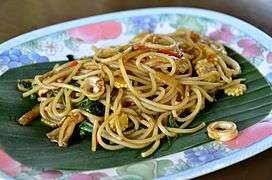Drunken noodles
Drunkard noodles (or pad kee mao[1], less frequently pad ki mao or pad kimao /ˌpæd kiː ˈmaʊ/;[2] Thai: ผัดขี้เมา, RTGS: phat khi mao, [pʰàt kʰîː māw]; is a stir fried noodle dish very similar to phat si-io, but with a slightly different flavor. In Thai, khi mao means drunkard. It is normally made with broad rice noodles, soy sauce, fish sauce, oyster sauce, garlic, meat, seafood, chili, fresh black pepper pods and holy basil, which give rise to its distinctive spiciness.[3] "Drunken fried rice" or khao phat khi mao is a similar dish.
 A plate of drunkard noodles in Chiang Mai, Thailand | |
| Type | Noodle |
|---|---|
| Place of origin | Thailand |
| Region or state | Thailand |
| Main ingredients | Shahe fen, soy sauce, fish sauce, garlic, meat, seafood or tofu, bean sprouts or other vegetables, Chili, holy basil |
Several theories exist on the naming of this dish. One states its origins stem from the use of rice wine in preparing this dish, but alcohol is generally not found in Thai recipes for the dish. Another supposes that it was devised by someone who came home drunk and made something to eat with available ingredients. Another slight variation describes using what remained in their fridge to cook a side dish for their alcohol drinking.
Gallery
 A variation where instant noodles are used
A variation where instant noodles are used A modern Thai fusion version with spaghetti
A modern Thai fusion version with spaghetti
See also
References
- "Drunken noodles or Pad Kee Mao? Language matters on ethnic menus". Ohio State News. Retrieved 2020-02-24.
- "pad kee mao". Oxford Dictionaries UK Dictionary. Oxford University Press. Retrieved 2017-03-20.
- Kris Yenbamroong, Garrett Snyder. Night + Market: Delicious Thai Food to Facilitate Drinking and Fun-Having Amongst Friends A Cookbook. Potter/Ten Speed/Harmony/Rodale, 2017. p. 45. ISBN 0451497880.